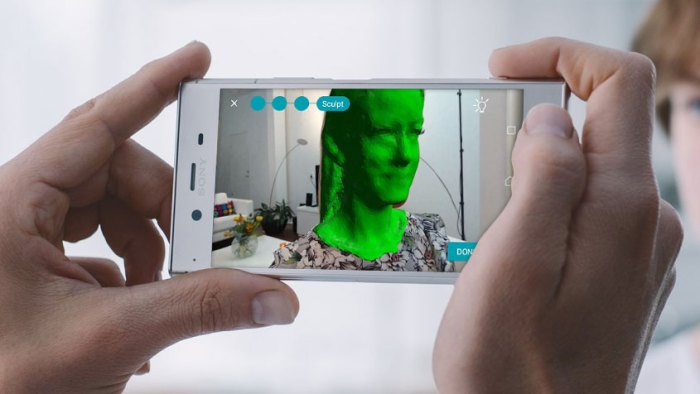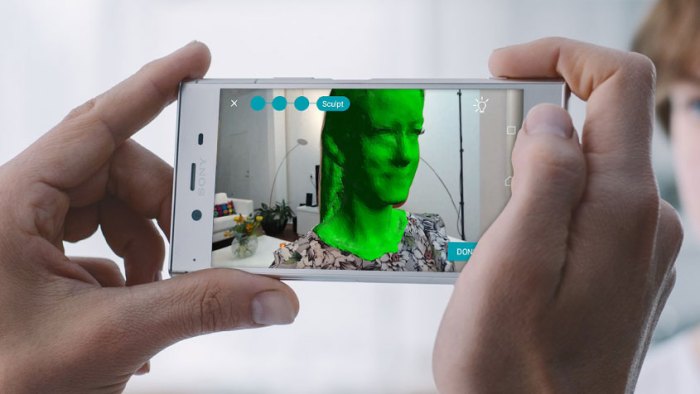Future trends and advancements in phone-based 3D scanning technology are rapidly transforming how we capture and interact with the three-dimensional world. The convergence of powerful smartphone cameras, sophisticated software algorithms, and increasingly accessible computing power is democratizing 3D scanning, opening up exciting possibilities across diverse sectors. This exploration delves into the key technological drivers, innovative applications, and future research directions shaping this dynamic field.
From the evolution of smartphone camera sensors and computational photography techniques to the integration of artificial intelligence in 3D reconstruction, the advancements are remarkable. We will examine the role of various technologies, including time-of-flight and structured light, and analyze how they contribute to improved accuracy and efficiency. Further, we will explore the potential of hardware enhancements, software improvements, and the integration with augmented and virtual reality, all contributing to a more user-friendly and accessible 3D scanning experience.
Security and Privacy Considerations
![]()
The increasing prevalence of phone-based 3D scanning technology raises significant concerns regarding the security and privacy of the captured data. This technology, while offering numerous benefits, presents unique challenges in safeguarding sensitive information, demanding careful consideration of data protection strategies and ethical implications. The potential for misuse of this technology necessitates proactive measures to mitigate risks and ensure responsible use.
The storage and sharing of 3D scan data from smartphones carry inherent security and privacy risks. 3D scans can capture highly detailed representations of individuals and objects, potentially revealing sensitive biometric information or proprietary designs. Unauthorized access to this data could lead to identity theft, fraud, intellectual property infringement, or even physical harm. For example, a 3D scan of a person’s face could be used to create a realistic mask for identity fraud, while a scan of a valuable artifact could facilitate the creation of counterfeit replicas.
Data Protection Strategies, Future trends and advancements in phone-based 3D scanning technology
Protecting user data requires a multi-layered approach. This includes employing robust encryption methods both during storage and transmission of 3D scan data. Data should be anonymized whenever possible, removing identifying information while retaining the essential features of the scan. Access control mechanisms, such as user authentication and authorization, are crucial to limit access to authorized personnel only. Regular security audits and penetration testing can identify vulnerabilities and help to prevent breaches. Furthermore, implementing data loss prevention (DLP) measures ensures that sensitive data is not accidentally or maliciously leaked. A well-defined data retention policy should also be established, specifying how long data is stored and under what conditions it is deleted. Transparency with users about data handling practices is also paramount, fostering trust and accountability.
Ethical Implications
The ethical implications of phone-based 3D scanning technology are far-reaching. The potential for misuse necessitates careful consideration of the societal impact. Issues of consent are central: individuals should be explicitly informed when they are being scanned and given the option to opt out. The potential for deepfakes and the creation of realistic but fabricated images or videos using 3D scan data raises significant concerns about misinformation and the erosion of trust. Furthermore, the technology’s use in surveillance or law enforcement raises questions about potential abuses of power and the erosion of privacy. Ethical guidelines and regulations are needed to ensure responsible development and deployment of this technology, balancing its potential benefits with the need to protect individual rights and societal well-being. A strong ethical framework should address issues of consent, data security, transparency, and accountability. The development of industry standards and best practices will be crucial in navigating these complex ethical challenges.
Future Research Directions

The field of phone-based 3D scanning is poised for significant advancements. Current limitations in accuracy, speed, and functionality present fertile ground for innovative research, promising a future where mobile 3D scanning becomes ubiquitous and seamlessly integrated into our daily lives. Several key areas require focused attention to unlock the full potential of this technology.
The pursuit of higher accuracy, faster scanning speeds, and enhanced functionality is driving ongoing research. Breakthroughs in these areas could dramatically alter the accessibility and applicability of mobile 3D scanning across diverse sectors. For example, improvements in depth sensing algorithms, coupled with advancements in computational photography, could lead to the creation of highly accurate 3D models from even challenging scenes with complex lighting conditions or highly reflective surfaces.
Improved Depth Sensing Algorithms
Current phone-based 3D scanning relies heavily on structured light or time-of-flight (ToF) methods for depth estimation. Research into more robust and accurate algorithms, including those leveraging artificial intelligence and machine learning, is crucial. For instance, the development of algorithms capable of handling occlusions and noisy data more effectively would lead to more accurate and complete 3D models. Further research into multi-sensor fusion techniques, combining data from different sensors like cameras and IMUs, could improve accuracy and robustness even further. This would reduce the reliance on ideal scanning conditions and increase the practical applicability of the technology.
Enhanced Computational Photography Techniques
Advances in computational photography offer a pathway to significantly improve the quality and efficiency of phone-based 3D scanning. Techniques like super-resolution and HDR imaging can enhance the input data, leading to higher-resolution and more detailed 3D models. Moreover, research into novel image processing algorithms specifically tailored for 3D reconstruction could significantly reduce processing time and computational requirements, making mobile 3D scanning faster and more accessible on a wider range of devices. For example, using AI-powered image enhancement before the 3D reconstruction process could significantly improve the quality of the final model.
Miniaturization and Power Efficiency
The miniaturization of 3D scanning components is essential for seamless integration into mobile devices. Research into smaller, more energy-efficient depth sensors and processing units is vital for extending battery life and reducing the overall size and weight of smartphones. This would make the technology more convenient for everyday use, opening up new possibilities for mobile 3D scanning applications. Consider the example of a future where a smartphone’s built-in 3D scanner is as commonplace and unobtrusive as its camera is today.
Expansion of Applications and Integration with Other Technologies
The integration of phone-based 3D scanning with other technologies like augmented reality (AR) and virtual reality (VR) holds immense potential. Imagine creating AR experiences that overlay accurate 3D models of real-world objects onto a user’s view, or designing VR environments based on precisely scanned real-world spaces. Further research should focus on developing seamless integration with existing mobile platforms and applications to fully realize the potential of this technology. For example, the development of easy-to-use mobile apps that allow users to seamlessly scan objects and share 3D models could significantly broaden the adoption of this technology.
The future of phone-based 3D scanning is bright, promising a more accessible and integrated approach to three-dimensional data acquisition. As technological advancements continue to refine accuracy, enhance user experience, and expand applications, we can anticipate a profound impact across industries, from healthcare and manufacturing to gaming and entertainment. Addressing the challenges of data management, security, and cost will be crucial in unlocking the full potential of this transformative technology, paving the way for widespread adoption and innovation.
Helpful Answers: Future Trends And Advancements In Phone-based 3D Scanning Technology
What are the limitations of current phone-based 3D scanning technology?
Current limitations include challenges with accuracy in complex geometries, susceptibility to environmental factors like lighting, and limitations in scanning very large or very small objects. Data processing and storage can also be demanding.
How much does phone-based 3D scanning cost?
The cost varies widely depending on the app, required hardware, and the level of processing power needed. Some basic apps are free, while professional-grade solutions can be quite expensive.
What privacy concerns are associated with phone-based 3D scanning?
Privacy concerns revolve around the potential for unauthorized collection and use of 3D scan data, particularly of individuals. Secure data storage and transmission protocols are crucial.
What is the future of 3D printing in conjunction with phone-based scanning?
The integration of phone-based 3D scanning with 3D printing holds immense potential for on-demand, personalized object creation, ranging from customized medical devices to personalized toys.
Check how to fix a smartphone camera that’s not focusing to inspect complete evaluations and testimonials from users.

